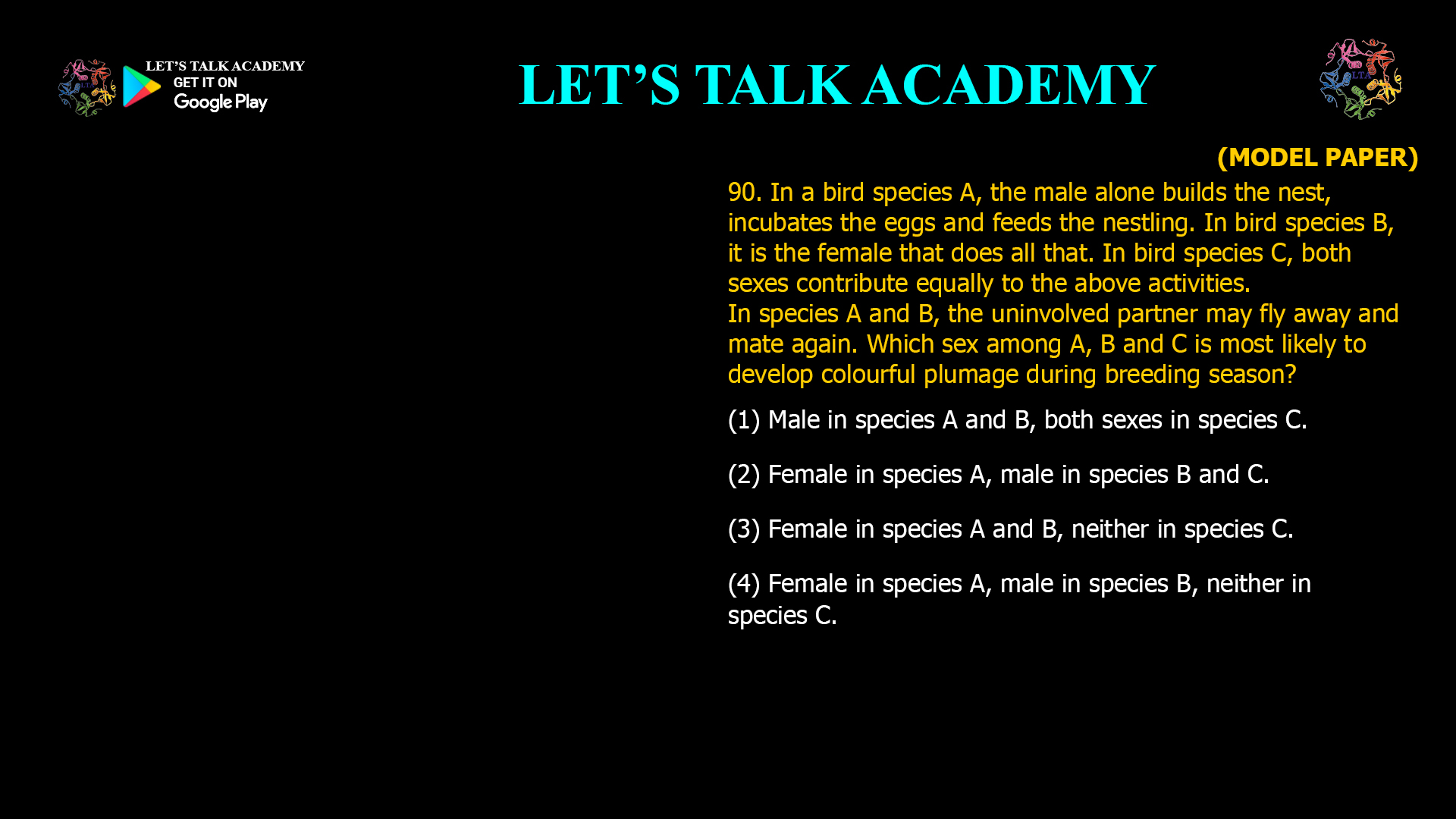- In a bird species A, the male alone builds the nest, incubates the eggs and feeds the nestling. In bird species B, it is the female that does all that. In bird species C, both sexes contribute equally to the above activities. In species A and B, the uninvolved partner may fly away and mate again. Which sex among A, B and C is most likely to develop colourful plumage during breeding season?
(1) Male in species A and B, both sexes in species C.
(2) Female in species A, male in species B and C.
(3) Female in species A and B, neither in species C.
(4) Female in species A, male in species B, neither in species C.In the avian world, the vibrant colors and striking patterns of breeding plumage are among the most spectacular sights in nature. But why do some birds develop such elaborate ornamentation, and why does this trait vary between males and females—or even appear in both? The answer lies in the interplay between parental care, sexual selection, and mating systems.
Let’s examine three bird species with contrasting parental care patterns:
-
Species A: The male alone builds the nest, incubates eggs, and feeds nestlings. The female is uninvolved and may mate again.
-
Species B: The female alone performs all parental duties, while the male is free to seek new mates.
-
Species C: Both sexes contribute equally to nest building, incubation, and feeding.
Which sex is most likely to develop colorful plumage during the breeding season in these scenarios?
The Evolutionary Logic of Colorful Plumage
Colorful plumage in birds is typically a result of sexual selection. When one sex competes for mates or needs to attract partners, natural selection favors ornamental traits that signal health, vigor, or genetic quality. The sex that is less involved in parental care is often under stronger sexual selection, as it is freer to seek additional mating opportunities and must compete for access to mates.
Species A: Male-Only Parental Care
In species where males provide all parental care, females are free to leave and mate with other males. This scenario leads to polyandry—one female mating with multiple males. In such systems, females compete for access to males and may develop more colorful or elaborate plumage as a result. However, classic studies and comparative analyses show that, in most bird lineages, it is still the male that tends to be more ornamented when he is the one left to attract mates for subsequent breeding attempts. Yet, in rare cases of extreme polyandry, females may be more colorful (e.g., phalaropes).
Species B: Female-Only Parental Care
Here, males are free to seek additional mates. This leads to polygyny, where males compete for access to multiple females. Males are under strong sexual selection, so they are more likely to develop colorful plumage to attract mates.
Species C: Biparental Care
When both sexes contribute equally to parental care, neither sex is free to seek additional mates. Sexual selection pressure is balanced, and both sexes have similar incentives to attract and retain a mate. In these species, both males and females are likely to be similarly ornamented or exhibit similar levels of plumage coloration. Studies show that mutual ornamentation is common in bird species with biparental care, as both sexes participate in mate choice and pair bonding.
Scientific Evidence
-
Sexual selection and parental care: Strong sexual selection on the sex that is less involved in care leads to greater ornamentation in that sex.
-
Polyandrous species: In rare cases, such as phalaropes, females are more colorful, but in most cases, male ornamentation is linked to freedom from parental duties.
-
Biparental care: Mutual ornamentation or similar plumage is common, reflecting shared sexual selection and parental investment.
Correct Answer and Explanation
The sex most likely to develop colorful plumage during the breeding season is:
Male in species A and B, both sexes in species C.
-
In species A and B, the sex not involved in parental care (and thus free to compete for mates) is the male, leading to greater male ornamentation.
-
In species C, both sexes share parental duties and are both involved in mate choice, so both are likely to be ornamented.
Conclusion
The evolution of colorful plumage in birds is intricately linked to patterns of parental care and sexual selection. When one sex is free from parental duties, it faces stronger sexual selection and is more likely to evolve bright, attractive plumage. In species where both sexes share parental care, mutual ornamentation is favored, reflecting the shared roles in both parenting and mate attraction. Understanding these dynamics provides a deeper appreciation for the diversity and beauty of bird life.
-




1 Comment
Kajal
October 13, 2025Option 1